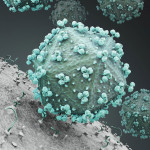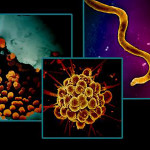It’s the most wonderful time of the year—or at least the most jam-packed, with Thanksgiving, World AIDS Day, Christmas, Kwanzaa, Hanukkah, New Year’s Eve and the 30th anniversary of Nasty Pig. The iconic, at-times controversial and always sex-positive LGBTQ fashion brand opened its first store, Re:Vision, on December 23, 1994, in what was then the heart of gay New York: Chelsea.
Nasty Pig cofounders David Lauterstein and Frederick Kearney were partners in every sense when they launched the brand. Today, they’re husbands and both thriving with HIV. Lauterstein, 55, just published a memoir, Sodomy Gods. The title references a genuine, queer spiritual outlook, and the book documents much more than their Nasty Pig business venture.
View this post on Instagram
A trained poet who worked in the hip-hop and dance music scene before branching into fashion full-time, Lauterstein paints a vivid portrait of creative underground gay culture in Gotham at the turn of the century. Sound Factory, Roxy, Kevin Aviance, Suzanne Bartsch, men, sex, Thierry Mugler, leather and the Lure are all present. As is HIV. So much HIV. And loss, addiction, survival, spirituality and celebration.
View this post on Instagram
POZ spoke with Lauterstein to learn more about his journey. Our interview has been edited for length and clarity.
We don’t want to give away the plot of Sodomy Gods. It’s such a refreshingly authentic, eye-opening read—you really capture a unique moment in time. Suffice to say that you, Fred and Nasty Pig are still here and better than ever. What were your goals as you wrote the memoir?
There was a push in publishing for founders of businesses to write their origin stories, so there was some pressure to write that. But I felt like telling a love story would be much more impactful and honest. I wanted to document the love that Fred and I have for each other and our community and our shared love for fashion. We are self-trained and didn’t take any business courses. We just kept out noses down and made clothing. But the narrative about us got away from us, and that’s our own fault. We didn’t court the press or do PR. So the book is a way to reclaim the narrative of why we started this and who we are as humans behind this brand that’s become a queer household name. Fred and I are two artists. It’s not like we’re these capitalists just out to make money. We started it out of love and continue to lead that way.
I also wanted to talk about spirituality and the role that HIV played. And I wanted to offer the younger generations a glimpse of what it was like just 30 years ago.

Nasty Pig founders David Lauterstein and Frederick Kearney in 1994Courtesy of Nasty Pig
How did HIV influence your aesthetics and the goals of your business.
In the ’90s, HIV was ever present within our community. Sex was connected with death, and it was hard to get past that. There was a statuesque look and vibe [in the gay scene] that was both physical, and, as far as I could tell in my early years, it was how we acted toward each other. The overriding vibe was “Look don’t touch.” Being promiscuous or what we’d call slutty was looked down upon. Our [LGBTQ] leadership was basically, “We’re just like everybody else. We’re not sick.” Nasty Pig was my expression and way of saying, “We’re not just like everybody else, but we are very necessary to the fabric of society.” Nasty Pig very much wanted to reclaim sex positivity. It also shaped the hopefulness that Fred and I wanted to put out in the world. I thought, When it’s really dark, maybe I can become a beacon and a light.
Lifesaving treatment for HIV became available in 1996, and now we have PrEP (pre-exposure prophylaxis) for prevention. Death and fear of sex are no longer at the forefront of most queer discussions. Has that changed Nasty Pig’s ethos or conversation with the community?
Both Nasty Pig and I have always been big advocates for public health. The brand’s reaction to HIV in the ’90s—our sexual positivity—has always overlapped with gay public health. During COVID, I worked with Demetre Daskalakis [who oversaw many HIV and sexual health programs for the city of New York before being tapped to do the same at the national level for the Centers for Disease Control and Prevention]. We came up with guidelines of how to have sex in the age of COVID. When mpox hit, [Nasty Pig] was at MAL [the Mid-Atlantic Leather weekend], and I gave up my booth so we could open a vaccination clinic with Demetre. And last year, we had what we called a PEP [post-exposure prophylaxis] rally at MAL; we teamed up with the District of Columbia Department of Health [to offer information and weekend doses of doxyPEP, a morning-after antibiotic pill that lowers the risk of acquiring chlamydia, gonorrhea and syphilis].
View this post on Instagram
For me, I want to try to take care of my community. Thank God, HIV isn’t where it was—but that doesn’t mean there aren’t challenges and conversations to be had. Let’s face it, you and I live in New York. But if you live in a smaller town [and] you go to Rite Aid to get an mpox vaccine, you are outing ourself. We’ve very privileged in these big cities. We have gay doctors and Callen Lorde [an LGBTQ community health center] and resources. Taking care of other people and ensuring they have a safe space is really important to me and Nasty Pig and what we do.
World AIDS Day is observed each December 1. How do you and Fred mark the occasion?
With Nasty Pig, we’re out there in the public for public health, but when it comes to World AIDS Day, we carve out time to remember who we are and to call back to those two little artists who started the company. My husband and I use this day as a quiet time to remember our friends who passed. It’s personal to us because we lived it.
We’re approaching gift-giving season. Can you update us on the business aspect of Nasty Pig?
Although we sell to about 45 stores around the world, the best place to find us is NastyPig.com. I want people to know we are an authentic queer brand that takes queer dollars and puts them in queer pockets. We’re living in such a post-truth society. But we are the realest deal going.
Right now, we’re selling fall/winter 2024. We’ve already designed 2025—the samples are coming in—and we’re starting to design spring/summer 2026. We work really hard to make this clothing.
View this post on Instagram
What are your most popular items?
Interestingly, our most popular item is a garment that covers up most of your body, which is our Union Suit. My husband loves reinventing the classics—10 years ago, he bought a union suit [a one-piece undergarment that has been around since the 1800s]. It had a butt flap which didn’t look particularly good, so he designed one to have the snaps come all the way down and go through the crotch. It’s made of a cotton rib—we manufacture our own fabric and trim.
Our black CORE Jock Strap—kind of the first gay branded jock strap—continues to sell, and so does the Snout Cap [a baseball cap with Nasty Pig’s snout logo]. That’s like a private nod in a public world. Those are the three top-selling items.
View this post on Instagram
Some might describe your models as hypermasculine, not unlike the Chelsea Boy clone look of the ’90s or Tom of Finland artwork. Today’s queer world seems to emphasize gender fluidity and a variety of body shapes. Does that change your market?
Queer aesthetics always change, and we have managed to be part of the conversation for the past 30 years. You mention Tom of Finland. When you study his art, what makes it so compelling? Yes, you’ve got the bulges and the ass and muscles—but you’ve also got eye contact, and it’s the engagement of the models that he draws that’s the most powerful part. And Nasty Pig is about connection. We have all different types of customers who interpret it through their own eyes. There have been lots of iterations from when we started. You’d be surprised at the range of customers we have. People want something authentic, and then they flip it up and wear it all different ways. It’s very cool to see.

A selection of Nasty Pig’s spring-summer 2024 fashion lineCourtesy of Nasty Pig
In your memoir, you recount in the early days of your business how someone left you a rude letter at your shop saying you were an embarrassment to the community for being so sexual and unapologetic about it. Do you still get snide comments like that?
The first 20 years, we were not liked by the community, but in 2013 and 2014, we began to break through. When we started the company, some said it was business suicide. I said, “It’s going to take two or three decades, but they’ll come around and see us for what we are.”
It’s interesting. Over the past three years, we’ve got a ton of recognition after no one really reported on us or talked about us. We’ve been sold at Nordstrom and honored at the White House, been given an entrepreneurial award from Start Out, the nation’s largest queer business organization and been honored at the Ali Forney Center [an LGBTQ youth shelter]. We don’t really get a lot of backlash now—we’ve allowed people to see what this brand is.
View this post on Instagram
I was reading Sodomy Gods in November, during the election and as it became clear that an anti-LGBTQ administration had won. Your comments in the memoir about hard-fought victories for equality not being taken for granted stood out to me as almost prophetic. In closing, do you have any lessons and inspiration you can share, especially at this moment in history?
I’ll give you an anecdote. The Saturday night following the Tuesday election, my COO Scott Wise was like, “Let’s go hear DJ Honey Dijon,” who was playing this warehouse party in Brooklyn, and Kevin Aviance was going to perform. Honey, Kevin and I came from the same club, the original Sound Factory. And my gut told me that Honey was going to deliver a lot of that ’90s uplifting vibe. And Scott—who’s in his early 30s and. who was a big help with the book—he said, “Is this what it felt like when you guys were in the Sound Factory, this feeling that was emanating throughout the [Brooklyn party]?” I said, “Yes, we went out to dance away all the pain and the bigotry and homophobia and transphobia.” And similarly, after the election, people were trying to shake it off. He said, “It’s so sad to know that nothing has really changed.” And I was like, “No, no. There were a couple hundred of us in 1994. In 2024, there are 5,000 people here. From 500 to 5,000. Our numbers have grown!” And if we were able to beat back HIV and beat back homophobia before, then we can do it again. There’s no turning back. If we can unite and push forward, we’re unstoppable. That won’t change, and that’s where I get my strength.
When things get hard, find joy and make more queer art and put it in people’s faces. Fight for your identity. Don’t be afraid to be defiant. Don’t be afraid to be happy. And don’t be afraid to celebrate.

Husbands David Lauterstein and Frederick Kearney are thriving with HIV. In 2024, their fashion brand Nasty Pig celebrates its 30th anniversary.Courtesy of Nasty Pig







1 Comment
1 Comment